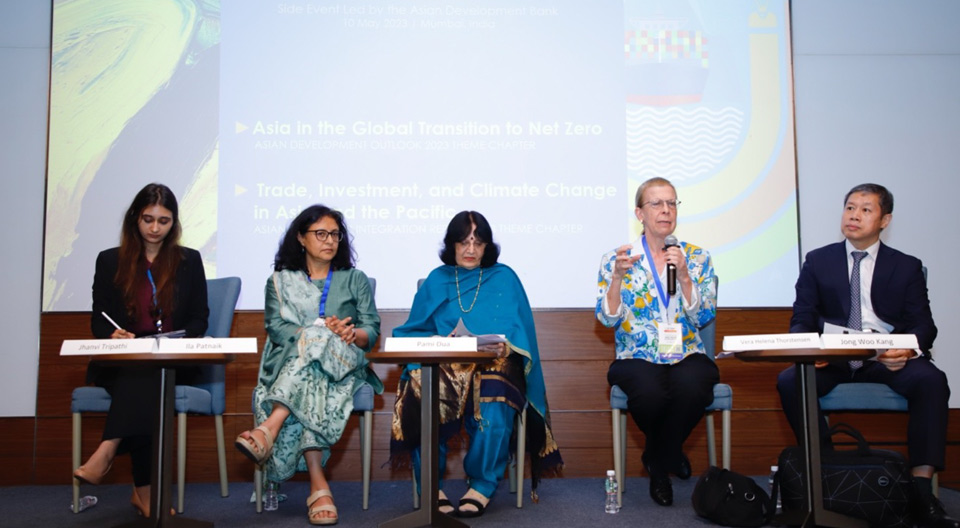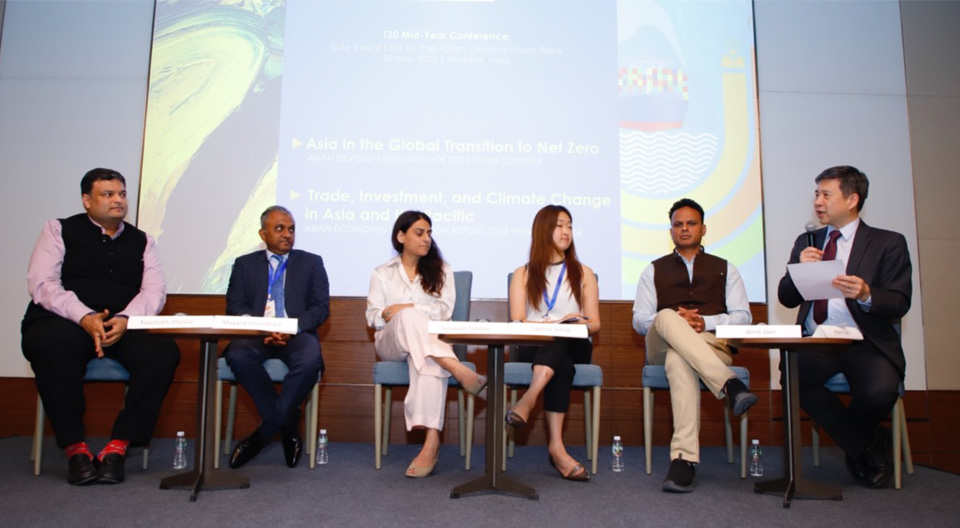The Asia-Pacific is at the centre of efforts to tackle climate change and achieve global net-zero emissions. While the region is amongst the most vulnerable to the impacts of climate change, it is also expected to be a key driver of global economic growth, and therefore, carbon emissions in the coming decades. In this context, the T20 Mid-Year Conference side event led by the Asian Development Bank aimed to take stock of the energy transition in the Asia Pacific and examine the potential socioeconomic consequences of the low carbon transition and implications for equity, including the financial hurdles associated with green transitions. The session consisted of a keynote address, presentations, and two panel discussions: 1) Priorities for Achieving a Net-Zero Transition 2) The Relationship between Trade, Investment, and Climate Change.
Mr Ashish Kumar Singh, Additional Chief Secretary, Accounts & Treasury, Finance Department, Maharashtra, highlighted the challenges confronting India and other developing economies in their quest to expand energy production capacity, enhance energy accessibility, and stimulate economic growth, all while striving for a transition to low-carbon systems. Four key sectors will be crucial to achieving rapid decarbonisation: renewable energy, energy efficiency, electrification of transport, and industrial decarbonisation. However, despite the declining costs of climate-friendly technologies in these sectors, the lack of capital accessibility and the perceived high risks associated with investments in developing economies continue to impede efforts to scale-up green energy initiatives. Looking ahead, there is an urgent necessity to realign global financial priorities and devise innovative mechanisms for redirecting both public and private funds towards climate action.
Presenting some insights from a recent ADB study, Albert Park, Chief Economist, Asian Development Bank, stressed that developing economies in Asia are poised to experience the highest economic losses as a consequence of the rapidly intensifying impacts of climate change. Effective climate action could provide five times the benefit compared to the costs for developing Asia. However, the path to net zero will require urgent policy actions including reforming prices to reflect the societal costs of carbon emissions, improved governance mechanisms for facilitating low carbon responses and ensuring fairness by protecting vulnerable populations.
The first panel discussion focused on priorities for Asia in its net-zero transition. Economic growth continues to be the key policy prerogative for developing economies in Asia. For these countries, most of the infrastructure needed for economic development, including energy production, is yet to be built. Therefore, their challenge lies not only in transitioning to cleaner energy sources but also in effectively prioritising the development of robust and sustainable energy infrastructure. In this context, the panellists highlighted several priority intervention areas for accelerating climate action in Asia:
- While different countries have their own climate policies and priorities, there is still substantial scope for improved regional policy coordination. Ms Saehee Jeong stated that 2023 is an opportune moment to strengthen regional collaboration as Asian countries are leading the G7, G20, and COP28 this year. This can be an important enabler of more ambitious national and regional climate targets and ensure sectoral targets are better aligned with overall priorities.
- Sub-national governments will also play a key role in the energy transition. Mr Kasutubh Dhavse stressed that energy transition was a key policy priority for the Maharashtra government
in India, and there was a constant effort by the state government to scale up promising clean technologies, including identifying pathways to enable technologies of the future such as battery storage and green hydrogen. For the energy transition to be successful, it is imperative for sub-national governments to focus on prioritising key sectors where green energy can make the most substantial impact, such as solar-based farming and electric mobility. Additionally, they should identify innovative financing mechanisms like green bonds to scale up the deployment of these technologies. - Accessing climate finance still remains the biggest challenge to ambitious climate action in developing Asia. However, resolving broader macroeconomic challenges will be a key prerequisite for accelerated climate finance. Dr. Suranjali Tandon pointed out that the current inflationary pressures and debt crisis have substantially reduced the fiscal space available to governments to invest in climate action. Increasing financial resources need rethinking of investment metrics, moving beyond financial returns to consider broader impacts on livelihoods and distributive consequences. Credit rating agencies will need to be reformed given that the current parameters applied by these agencies put developing economies at a significant disadvantage.
- Governments and multilateral institutions lack the financial ability to mobilise the scale of capital needed for rapid climate action. In this scenario, private capital must step up to fill in the massive climate finance deficit. Mr Amit Jain pointed out that only around 49 percent of the total climate finance available today is provided by the private sector. This means that one dollar of public investment crowds in less than one dollar of private investment, which is highly inadequate. There is an urgent need to develop new bankable frameworks and credit enhancement mechanisms so that investments from the public sector can have a bigger footprint than the amount invested, by crowding in large magnitudes of private capital. Moreover, loan dependent model of climate finance will have to be rethought and private sectors will have to be increasingly nudged to take on greater risks and deploy different forms of capital in developing economies.

The second panel discussion titled “The Relationship between Trade, Investment and Climate Change”, began with a presentation by Dr Jong Woo Kang of the Asian Development Bank (ADB) on Asia and the Pacific and their relationship with trade and climate change.
The presentation highlighted how Asia and the Pacific are on the frontline of climate change and how it is necessary to adopt climate-smart technologies to grow sustainably. The presentation provided sector-wise statistics on carbon emissions by different countries. Broadly, the presentation stated that policymakers can focus on four pillars to make trade and investment a part of climate solutions, namely, i) Promoting trade in environmental goods and services, ii) Nurturing green businesses, iii) Enhancing international cooperation on regulations, and iv) Developing carbon pricing mechanisms. The presentation also touched upon the impact of the European Union’s Carbon Border Adjustment Mechanism (CBAM) on different countries depending on their trade exposure. Dr Kang highlighted that regional and global cooperation will become even more important in combating climate change going forward.
The panellists put forth key challenges and policy interventions to make trade and investment part of the climate solution:
- Adopting universally implementable standards: Dr Vera Thorstensen highlighted the disconnect between the trade, investment, and United Nations (UN) systems when it comes to environmental regulation and the continued privatisation of environmental standards which negatively impacts emerging economies. She mentioned that countries need to implement standards that can be equally accepted and implemented by emerging economies.
- Diversifying supply chains: Dr Pami Dua mentioned that Asian economies can reduce the emissions embedded in their trade by moving up global value chains and diversifying their exports. She also mentioned that governments can shift to a service-based economy. Lastly, she mentioned that it is important to increase cooperation within Asia to address climate change.
- Increasing cooperation: Dr. Ila Patnaik highlighted the global impact of climate change, and the need to change countries’ approach in addressing the problem. She mentioned that it is important to be aware of the impact that a country’s policies may have on another country and how these policies may affect the environment globally.
- Changing manufacturing patterns: Ms Jhanvi Tripathi mentioned how Asia’s manufacturing industry was driven by demand from Western economies, and gave examples of countries moving up the value chain, and thus, shifting manufacturing patterns.
Responding to Dr Kang’s query on ways to balance direct economic growth with climate change actions for developing countries, Ms Tripathi stated that India has been incentivising green production, and mentioned the increase in green investments. Dr Dua explained the relationship between climate change and inflation, and how monetary policies can be designed to mitigate inflation pressure while supporting climate actions. She highlighted the need for targeted support for the vulnerable, and the role of the governments in investing in technology that increases the productive capacity and increases the resilience of the economy. She also mentioned the role of monetary policy, and the role of central banks in combating climate change, including the development of sustainable capital markets and promoting green and low-carbon financing options.
Moving to trade facilitation, D. Thorstensen mentioned various measures can be taken to facilitate trade in environmental goods and services. She spoke about the top-down approach of creating standards in the European Union, the bottom-up approach in the United States, and the flexibility of manufacturing in China, and the need to create universally acceptable and implementable standards. She spoke of the need for developing countries to do more work in the domain of standard setting and also mentioned that the Carbon Border Adjustment Mechanism (CBAM) is reproducing the models of developed countries. Dr Patnaik spoke about the impact of CBAM on exporters, and shared the challenges faced by the industry with regard to drawing electricity for production, especially in remote areas. She mentioned that the industry will gear up for disclosures to be made under CBAM, and highlighted the need for access to renewable electricity in the process of moving towards ‘green’.
The panel then answered questions from the audience concerning production versus consumption as a basis for measuring the economic welfare of the people, the dependence on fossil fuel subsidies in emerging economies, and the standards followed by EU industries. Dr. Kang highlighted the relationship between consumption and its environmental footprint. In conclusion, he emphasized the need for collective action—a theme that permeated both Panel discussions.
This event report has been compiled by Urvi Tembey and Promit Mookherjee





